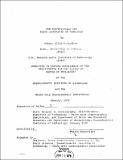| dc.contributor.advisor | C.O. Bowin. | en_US |
| dc.contributor.author | Folinsbee, Robert Allin | en_US |
| dc.contributor.other | Woods Hole Oceanographic Institution. | en_US |
| dc.date.accessioned | 2012-02-24T18:57:04Z | |
| dc.date.available | 2012-02-24T18:57:04Z | |
| dc.date.issued | 1972 | en_US |
| dc.identifier.uri | http://hdl.handle.net/1721.1/69201 | |
| dc.description | Thesis (Ph. D.)--Joint Program in Oceanography (Massachusetts Institute of Technology, Dept. of Earth and Planetary Sciences and the Dept. of Meteorology; and the Woods Hole Oceanographic Institution), 1972. | en_US |
| dc.description | Includes bibliographical references (p. 153-159). | en_US |
| dc.description.abstract | Free-air and simple Bouguer anomaly maps of the Venezuelan continental margin (from 60°W to 72°W and from 7°N to 13°N) are presented. The major features of the free-air map are: the large lows associated with the deep sedimentary basins, -200 mgal in the Eastern Venezuela basin and -164 mgal in the Maracaibo basin; the high of greater than 300 mgal over the Venezuelan Andes; and a belt of highs associated with the offshore islands extending from Blanquilla to Curacao and then over the Guajira peninsula, where they terminate. The Bouguer anomaly map shows a large low (-196 mgal) over the Eastern Venezuela basin and relative minimums over the coastal mountains. A minimum associated with the Venezuelan Andes is shifted to the northwest of the topographic axis and lies over the flank of the Andes and part of the Maracaibo basin. Using the gravity data, structural sections were constructed for a series of profiles across the Venezuelan Andes and Caribbean mountains. They show that there is no light.crustal root under the Andes, the relative mass excess is as much as 600 kg/cm2 , and that there is an excess of low density material under the Maracaibo basin. This appears to be caused by a combination of a southeastward dipping shear zone in the lithosphere under the basin-mountain boundary and a component of compressive stress perpendicular to this zone, both of which have resulted in the uplift of the crust under the Andes, and downwarp under the basin. The apparent flexural rigidity of the lithosphere under the Maracaibo basin is 0.6 x 10 newton-m, a normal value for lithosphere deformations of Miocene age. The Caribbean mountains have a light crustal root which has been formed by the sliding of blocks of crustal material from the north over the rocks to the south, and perhaps by the under thrusting of oceanic crust under the continental crust. This under thrusting may have been a result of the formation of a downgoing slab of lithosphere along the Venezuelan continental margin during the late Cretaceous. The downgoing slab may have existed until mid-Eocene time. The gravity minimum over the Eastern Venezuela basin is due to the down warping of lighter crustal material into the higher density mantle. This may be a result of compression from the north along a north-south direction causing down buckling buckling of the lithosphere. The present deformation along the northern boundary appears to be due to differences in relative motion between the North and South American plates. Because the Caribbean mountains are partially isostatically compensated, while the Venezuelan Andes are above isostatic equilibrium, this suggests that the relative motion of the Caribbean plate with respect to the South American plate is eastward. The compressive stress across the boundary in the region of the Venezuelan Andes is probably greater than the compressive stress across the Caribbean mountains. | en_US |
| dc.description.statementofresponsibility | by Robert Allin Folinsbee. | en_US |
| dc.format.extent | 160 p. | en_US |
| dc.language.iso | eng | en_US |
| dc.publisher | Massachusetts Institute of Technology | en_US |
| dc.rights | M.I.T. theses are protected by
copyright. They may be viewed from this source for any purpose, but
reproduction or distribution in any format is prohibited without written
permission. See provided URL for inquiries about permission. | en_US |
| dc.rights.uri | http://dspace.mit.edu/handle/1721.1/7582 | en_US |
| dc.subject | Joint Program in Oceanography. | en_US |
| dc.subject | Earth Planetary Sciences. | en_US |
| dc.subject | Meteorology. | en_US |
| dc.subject | Woods Hole Oceanographic Institution. | en_US |
| dc.subject.lcsh | Marine geophysics | en_US |
| dc.subject.lcsh | Plate tectonics | en_US |
| dc.title | The gravity field and plate boundaries in Venezuela | en_US |
| dc.type | Thesis | en_US |
| dc.description.degree | Ph.D. | en_US |
| dc.contributor.department | Joint Program in Oceanography | en_US |
| dc.contributor.department | Massachusetts Institute of Technology. Department of Meteorology | en_US |
| dc.contributor.department | Woods Hole Oceanographic Institution | en_US |
| dc.contributor.department | Massachusetts Institute of Technology. Department of Earth, Atmospheric, and Planetary Sciences | |
| dc.contributor.department | Massachusetts Institute of Technology. Department of Ocean Engineering | |
| dc.identifier.oclc | 22375021 | en_US |
